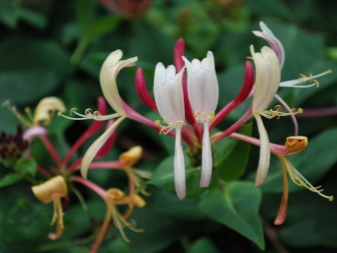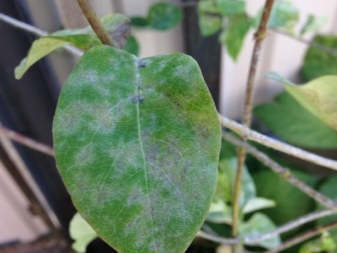Features of Serotin's honeysuckle and its cultivation

To plant and decorate the site, many gardeners choose decorative curly honeysuckle. At the same time, inedible varieties of crops look most impressive, moreover, they require less care. One of the best varieties for gardening is Serotin's honeysuckle. This unique culture will be discussed in the article.


general description
Curly honeysuckle Serotin has French roots, but it is used not only in France. The plant is successfully used for landscaping gardens and sites in many European countries. In another way, the culture is called Primorskaya.
Serotina is a perennial shrub very similar to a vine. The described variety belongs to deciduous. The height of the plant usually ranges from 4 to 5 meters, while the culture grows very quickly, adding up to 100 cm per year. Young shoots do not have a cannon, but they have quite a lot of leaves. The latter have a dark green color and are quite impressive in size.

In shape, the leaf plates resemble an egg. In autumn, they turn yellow, which does not detract from the decorative effect of the variety.
Most of all Serotin is prized for its flowering. And it looks really interesting: the flowers are large, collected in large inflorescences. Their color also deserves attention: in the central part it is milky white, and the outer area of the bud is painted in dark or bright red, sometimes purple. The bloom is accompanied by a very strong aroma.
The first flowering can be expected as early as 3 years of the life of the bush. After the flowers fall, the ovaries are formed, and then the berries. They also look beautiful: round, small, red, there are quite a few of them. You cannot eat such fruits, they serve only for decorative purposes. Otherwise, you can get severely poisoned.


Landing
Having decided to grow Serotin on your site, you must familiarize yourself in advance with all the rules for planting this culture. The first step is to choose the right seedling. Buy honeysuckle of the described variety only in nurseries, in no case from hands. The leaves should be green, shiny, and no signs of damage may be present on the roots.
It is best to buy seedlings with an earthen clod, but if this is not possible, then the roots must be wrapped with a wet cloth during transportation.

In addition to choosing a seedling, you need to take a responsible attitude to the selection of a site for growing Serotin. Honeysuckle is very fond of the sun. The more it is, the larger and more beautiful the flowers will be. Even with light shading, the decorative effect of the shrub suffers. Winds should also be avoided, because young vines can break from a strong gust. The soil should be picked up light, without excess sand and salt. The soil should be air permeable and have neutral acidity.

Honeysuckle is planted at the very end of August, in an extreme case - in the first days of September. The hole is prepared in a couple of days. Its depth should be 0.3 meters, diameter - 0.4. If you plan to plant several bushes at once, then you need to take care of the distance between them. According to the recommendations of gardeners, it should be 1.5-2 meters.
The bottom of the hole must be lined with drainage. You will also need to make the following components:
- compost - 10 kg;
- superphosphate - 100 g;
- potassium salt - 50 g.


The above components are thoroughly mixed with fertile soil. Before planting, the seedling is soaked in growth stimulants for a couple of hours, so that later it adapts faster.The roots can be trimmed slightly. The honeysuckle is lowered vertically into the hole, sprinkled with earth gradually, avoiding the appearance of air pockets.
After planting, the soil must be tamped a little, and then watered with fresh warm water. The twigs can be shortened by a couple of centimeters. A layer of mulch for each bush is laid out without fail.


Care
Serotin does not require any special care, but you still need to learn the minimum rules. The plant is very fond of water, and with a lack of it, it always slows down in growth. Therefore, watering must be carried out in a timely manner. If the season is wet, then once a month will be enough, but if it is hot and dry outside, you will have to water about 6 times in 30 days. At the same time, about 5 ten-liter buckets will be required for each bush.
After watering, the soil is cultivated with a ripper, but this should be done shallowly, since the root system of Serotina is superficial. It is also a good solution to put mulch. Organic material will retain moisture, and also slow down the growth of weeds.

The described variety responds very well to fertilizers. But you need to make them only in the second year. In the spring, as the buds swell, honeysuckle is fertilized with a solution of chicken or mullein, supplemented with superphosphate (40 grams). During flowering, mineral components for ornamental shrubs will provide excellent support to plants. You can buy them at any gardening store. But in the fall, they fall asleep only with humus, and as mulch. Each trunk circle will require 5 kilograms of such a product.


Since the plant grows quickly, pruning is vital. But it, like top dressing, is carried out only in the second year. So, honeysuckle will definitely need pruning after winter. And here one caveat must be taken into account: the vast majority of horticultural crops are cut off before the start of sap flow, but not honeysuckle. The structure of the bush is such that it is simply impossible to see the difference between diseased and healthy shoots in the absence of foliage on them. Therefore, it is necessary to cut off when the leaves appear.
Dry and frozen shoots, as well as those that have been affected by pests or diseases, are subject to removal. Healthy specimens will need to be trimmed 0.3 meters to stimulate good growth.

You will also need a support so that the shrub looks beautiful and has the correct shape.
It is necessary to rejuvenate the bushes every couple of years. At the same time, old branches are removed, as well as those that thicken the bush. Without such pruning, the plant will look unkempt. If the plant is more than 6 years old, then it will also need sanitary pruning.

The winter hardiness of the culture is quite high, but the plants will still have to be covered in the cold season. So, in the southern regions, plants are simply mulched with organic matter, this is quite enough. If something freezes over the winter, then pruning will quickly resolve this issue. But in cooler regions, you will need to remove the honeysuckle from the support. The plant is bent to the ground, fixed, covered with organic matter or agrofibre. It is necessary to get rid of the protection in the middle of spring.

Reproduction
There are several ways to multiply Serotin. At the same time, seed is practically never used due to its duration and labor input. And flowering with this type of reproduction occurs only at the 5th year, which is very inconvenient.

It is much easier to use vegetative techniques. For example, grafting will be the simplest way. It is necessary to select lignified shoots and separate them from the mother bush at the end of March. Shoots should be strong and young, well developed. They need to be cut into pieces of 0.2 m and planted in moist soil, covered with plastic. They are grown according to the same principle as ordinary seedlings. The cuttings will be ready for transplanting in about 21-30 days.

The division of the bush is used for those specimens that are already 5 years old. It is necessary to dig out a bush, carefully divide it with a pruner.Wounds are compulsorily processed, for this you can use activated carbon. You don't need to do anything else, since the resulting bushes can be immediately planted in a permanent place.

Diseases and pests
It is worth noting that Curly Serotin is affected by diseases and pests only in the most extreme cases. This is facilitated by the mistakes of gardeners, namely:
- non-compliance with the distance between the bushes;
- excessive watering;
- disembarkation in the shade or in a place with a close occurrence of groundwater;
- planting next to crops unfavorable for honeysuckle.

But even so the only thing that a plant can attack is powdery mildew... If you are a novice gardener and do not quite know all the intricacies of care, or spring and summer in your region are humid, then it is recommended to carry out prevention by treating the plants with copper-based fungicides.
The main pest of honeysuckle is aphids. To prevent it, it is necessary to strictly control the number of anthills on the site. If the parasite still showed itself, then in the initial stages, Green Soap will help. You can also fight aphids with a solution based on ordinary laundry soap, infusion of chamomile, garlic and tobacco dust.


Since the fruit is not supposed to be eaten, it is possible to destroy the parasites with strong insecticides. The main thing is to do this on a calm day so that the poison does not scatter throughout the entire area.
Beautiful examples
Serotin is an incredibly showy plant that is widely used in landscaping. If planted as a groundcover, the shoots will gracefully curl along the ground, creating a delicate green carpet. But the landing near the supports looks more interesting. For example, honeysuckle can be planted next to a fence. Then she will beautifully wrap her around, creating the effect of a hedge.

No less decoratively curly honeysuckle looks on the walls of gazebos, pergolas, arches, especially during the flowering period. They also plant it separately, supplementing it with plants of contrasting color. Lavender, petunia, buttercups look very beautiful next to them. And the red berries that appear will be interesting to set off white or yellow flowers.
To make sure that honeysuckle really represents one of the best options for a site, we suggest that you familiarize yourself with some beautiful examples of planting it.













The comment was sent successfully.